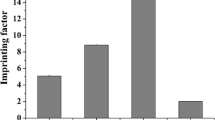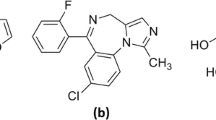Abstract
The aim of this work was to synthesize a pantoprazole-imprinted polymer (MIPs) and study its binding and release properties in an aqueous media. Methacrylic acid (MAA), methacrylamide (MAAM), hydroxyethyl methacrylate (HEMA), and 4-vinyl pyridine (4VP) were tested as functional monomers. Different solvents were also applied as polymerization media under heat or UV radiation. The optimized MIP was prepared in chloroform as a solvent, 4-vinyl pyridine as a functional monomer, and ethylene glycole dimethacrylate (EGDMA) as a crosslinker monomer under UV irradiation. Binding and release properties of MIP were studied in comparison with a non-imprinted polymer (NIP) in aqueous media, at different pH values. The protective effect of polymer for drugs against acidic conditions was evaluated at pH 2. Results indicated that the MIP had superior binding properties compared to NIP for pantoprazole. The percentage of drug released from MIP was significantly less than from NIP at all pH values, which was attributed to the presence of imprinted cavities in the MIP matrix. MIP also had a stronger protective effect for pantoprazole in acidic media, in comparison with NIP.
Similar content being viewed by others
References
Alexander C, Andersson HS, Andersson LI, Ansell RJ, Kirsch N, Nicholls IA, O’Mahony J, Whitcombe MJ. Molecular imprinting science and technology: a survey of the literature for the years up to and including 2003. J Mol Recognit, 2006, 19: 106–180
Mohajeri SA, Ebrahimi SA. Preparation and characterization of a lamotrigine imprinted polymer and its application for drug assay in human serum. J Sep Sci, 2008, 31: 3595–3602
Moller K, Nilsson U, Crescenzi C. Synthesis and evaluation of molecularly imprinted polymers for extracting hydrolysis products of organophosphate flame retardants. J Chromatogr A, 2001, 938: 121–130
Hadizadeh F, Hassanpour Moghadam M, Mohajeri SA. Application of molecularly imprinted hydrogel for the preparation of lactose-free milk. J Sci Food Agric, 2013, 93: 304–309
Liu Y HK, Haginaka J. Monodispersed, molecularly imprinted polymers for cinchonidine by precipitation polymerization. Talanta, 2010, 80: 1713–1718
Suedee R JC, Lindner W, Viernstein H, Songkro S, Srichana T. Development of a ph-responsive drug delivery system for enantioselective-controlled delivery of racemic drugs. J Control Release, 2010, 142: 122–131
Alexiadou DK, Maragou NC, Thomaidis NS, Theodoridis GA, Koupparis MA. Molecularly imprinted polymers for bisphenol a for HPLC and SPE from water and milk. J Sep Sci, 2008, 31: 2272–2282
Suárez-Rodríguez JL, Maragou NC. Fluorescent competitive flow-through assay for chloramphenicol using molecularly imprinted polymers. 2001, 16: 955–961
Liu X, Ouyang C, Zhao R, Shangguan D, Chen Y, Liu G. Monolithic molecularly imprintedpolymer for sulfamethoxazole andmolecular recognition properties in aqueous mobile phase. Anal Chim Acta, 2006, 571: 235–241
Puoci F, Iemma F, Muzzalupo R, Spizzirri UG, Trombino S, Cassano R, Picci N. Spherical molecularly imprinted polymers (SMIPs) via a novel precipitation polymerization in the controlled delivery of sulfasalazine. Macromol Biosci, 2004, 4: 22–26
Singh I, Kumar P. Formulation and optimization of tramadol loaded alginate beads using response surface methodology. Pak J Pharm Sci, 2012, 25:741–749
Giovannoli C, Baggiani C, Anfossi L, Giraudi G. Molecularly imprinted polymer formats for capillary electrochromatography. Electrophoresis, 2008, 29: 3349–3365
Mullett WM, Walles M, Levsen K, Borlak J, Pawliszyn J. Multidimensional on-line sample preparation of verapamil and its metabolites by a molecularly imprinted polymer coupled to liquid chromatography-mass spectrometry. J Chromatogr B Analyt Technol Biomed Life Sci, 2004, 801: 297–306
Das R, Agrawal YK. Simultaneous monitoring of selective serotonin reuptake inhibitors in human urine, plasma and oral fluid by reverse-phase high performance liquid chromatography. J Chromatogr Sci, 2013, 51: 146–154
Rostamizadeh K, Vahedpour M, Bozorgi S. Synthesis, characterization and evaluation of computationally designed nanoparticles of molecular imprinted polymers as drug delivery systems. Int J Pharm, 2010, 424: 67–75
Patricia R, Mónica Díaz-Bao, Rocío Barreiro, Alberto C, Cristina F. Application of molecularly imprinted polymers in food analysis: clean-up and chromatographic improvements. Cent Eur J Chem, 2012, 10: 766–784
Mohajeri SA, Hosseinzadeh H, Keyhanfar F, Aghamohammadian J. Extraction of crocin from saffron (crocus sativus) using molecularly imprinted polymer solid-phase extraction. J Sep Sci, 2010, 33: 2302–2309
Mayes AG, Whitcombe MJ. Synthetic strategies for the generation of molecularly imprinted organic polymers. Adv Drug Deliv Rev, 2005, 57: 1742–1778
Mohajeri SA, Karimi G, Aghamohammadian J, Khansari MR. Clozapine recognition via molecularly imprinted polymers; bulk polymerization versus precipitation method. J Appl Polym Sci, 2011, 121: 3590–3595
Mohajeri SA, Karimi G, Khansari MR. Clozapine imprinted polymers: synthesis, characterization and application for drug assay in human serum. Anal Chim Acta, 2010, 683: 143–148
Mohajeri SA, Malaekeh-Nikouei B, Sadegh H. Development of a ph-responsive imprinted polymer for diclofenac and study of its binding properties in organic and aqueous media. Drug Dev Ind Pharm, 2012, 38: 616–622
Imaz I, Rubio-Martínez M, García-Fernández L, García F, Ruiz-Molina D, Hernando J, Puntes V, Maspoch D. Coordination polymer particles as potential drug delivery systems. Chem Commun, 2010, 24: 4737–4739
Vilar G, Tulla-Puche J, Albericio F. Polymers and drug delivery systems. Curr Drug Deliv, 2012, 9: 367–394
Bacaksiz A, Taker ME, Buyukpinarbasili N, Inan O, Tasal A, Sonmez O, Erdogan E, Turfan M, Akdemir OC, Ertas G. Does pantoprazole protect against reperfusion injury following myocardial ischemia in rats? Eur Rev Med Pharmacol Sci, 2013, 17: 269–275
Sachs G, Shin JM, Hunt R. Novel approaches to inhibition of gastric acid secretion. Curr Gastroenterol Rep, 2010, 12: 437–447
Sahebnasagh A, Karimi G, Mohajeri SA. Preparation and evaluation of histamine imprinted polymer as a selective sorbent in molecularly imprinted solid-phase extraction coupled with high performance liquid chromatography analysis in canned fish. Food Anal Method, 2013, 7: 1–8
Malaekeh-Nikouei B, Vahabzadeh SA, Mohajeri SA. Preparation of a molecularly imprinted soft contact lens as a new ocular drug delivery system for dorzolamide. Curr Drug Deliv, 2013, 10: 279–285
Suedee R, Jantarat C, Lindner W, Lindner W, Viernstein H, Songkro S, Srichana T. Development of a ph-responsive drug delivery system for enantioselective-controlled delivery of racemic drugs. J Control Release, 2010, 142: 122–131
Cunliffe D, Kirby A, Alexander C. Molecularly imprinted drug delivery systems. Adv Drug Deliv, 2005, 57: 1836–1853
Mohajeri SA, Ebrahimi SA. Preparation and characterization of a lamotrigine imprinted polymer and its application for drug assay in human serum. J Sep Sci, 2008, 31: 3595–3602
Suedee R, Srichana T, Rattananont T. Enantioselective release of controlled delivery granules based on molecularly imprinted polymers. Drug Deliv, 2002, 9: 19–30
Mirzaei M, Hassani Najafabadi SA, Abdouss M, Azodi-Deilami S, Asadi E, Milani Hosseini MR, Piramoon M. Preparation and utilization of microporous molecularly imprinted polymer for sustained release of tetracycline. J App Polym Sci, 2012, 128: 1557–1562
Sellergren B, Allender CJ. Molecularly imprinted polymers: a bridge to advanced drug delivery. Adv Drug Deliv Rev, 2005, 57: 1733–1741
Khodaverdi E, Akbari A, Tekie FS, Mohajeri SA, Zohuri G, Hadizadeh F. Sustained delivery of amphotericin b and vancomycin hydrochloride by an injectable thermogelling tri-block copolymer. PDA J Pharm Sci Technol, 2013, 67: 135–145
Liu Y, Hoshina K, Haginaka J. Monodispersed, molecularly imprinted polymers for cinchonidine by precipitation polymerization. Talanta, 2010, 80: 1713–1718
Haupt K. Imprinted polymers-tailor-made mimics of antibodies and receptors. Chem Commun, 2003, 21: 171–178
Huang X, Zou H, Chen X, Luo Q, Kong L. Molecularly imprinted monolithic stationary phases for liquid chromatographic separation of enantiomers and diastereomers. J Chromatogr A, 2003, 984: 273–282
Zhu L, Xu X. Selective separation of active inhibitors of epidermal growth factor receptor from caragana jubata by molecularly imprinted solid-phase extraction. J Chromatogr A, 2003, 991: 151–158
Author information
Authors and Affiliations
Corresponding author
Rights and permissions
About this article
Cite this article
Mohajeri, S.A., Sajadi Tabassi, S.A., Hassanpour Moghadam, M. et al. Preparation of a pH-sensitive pantoprazole-imprinted polymer and evaluation of its drug-binding and -releasing properties. Sci. China Chem. 57, 857–865 (2014). https://doi.org/10.1007/s11426-014-5091-1
Received:
Accepted:
Published:
Issue Date:
DOI: https://doi.org/10.1007/s11426-014-5091-1




